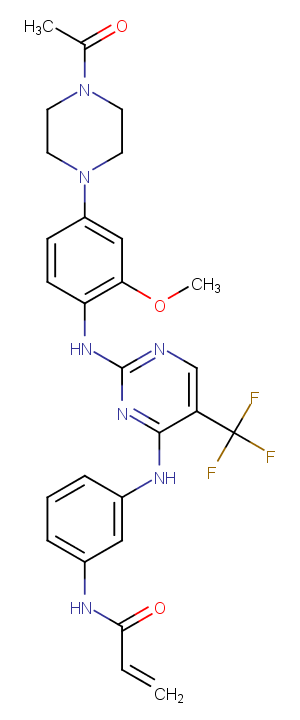Powder: -20°C for 3 years | In solvent: -80°C for 1 year


Rociletinib (CNX-419) is an orally available small molecule, irreversible inhibitor of epidermal growth factor receptor (EGFR) with potential antineoplastic activity.

| Pack Size | Availability | Price/USD | Quantity |
|---|---|---|---|
| 5 mg | In stock | $ 45.00 | |
| 10 mg | In stock | $ 68.00 | |
| 25 mg | In stock | $ 100.00 | |
| 50 mg | In stock | $ 126.00 | |
| 100 mg | In stock | $ 207.00 | |
| 1 mL * 10 mM (in DMSO) | In stock | $ 53.00 |




| Description | Rociletinib (CNX-419) is an orally available small molecule, irreversible inhibitor of epidermal growth factor receptor (EGFR) with potential antineoplastic activity. |
| Targets&IC50 | EGFR (WT):303.3 nM(Ki), EGFR (L858R/T790M):21.5 nM(Ki) |
| In vitro | CO-1686 demonstrates significant dose-dependent tumor growth inhibition across all models of EGFR mutations, including transgenic mice expressing EGFRL858R- and EGFRL858R/T790M. |
| In vivo | CO-1686 selectively inhibits the growth of NSCLC (non-small cell lung cancer) cells expressing mutant EGFR, with a GI50 range of 7 to 32 nM, and induces apoptosis. NSCLC cell lines resistant to CO-1686 show signs of epithelial-mesenchymal transition and increased sensitivity to AKT inhibitors. In cells expressing mutant EGFR, CO-1686 inhibits p-EGFR with an IC50 range of 62 to 187 nM, while also inhibiting EGFR phosphorylation in three types of cells expressing WT (wild type) EGFR, with an IC50 of >2,000 nM. |
| Kinase Assay | Inhibition Kinetics Studies: Recombinant human wild-type and T790M/L858R double mutant EGFR, both Nterminal GST-tagged, are used in the assay. The Omnia continuous read assay is performed as described by the vendor. |
| Cell Research | Cells are seeded at 3,000 cells per well in growth media supplemented with 5% FBS, 2 mmol/L, L-glutamine, and 1% penicillin–streptomycin, allowed to adhere overnight, and treated with a dilution series of test compounds for 72 hours. Cell viability is determined by CellTiter-Glo, and results are represented as background-subtracted relative light units normalized to a dimethyl sulfoxide (DMSO)–treated control. Growth inhibition (GI 50) values are determined by GraphPad Prism 5.04. MK-2206 and XL-880 compounds are obtained from Selleck Chemical. CI data are generated using CalcuSyn.(Only for Reference) |
| Synonyms | AVL-301, CNX-419, CO-1686 |
| Molecular Weight | 555.55 |
| Formula | C27H28F3N7O3 |
| CAS No. | 1374640-70-6 |
Powder: -20°C for 3 years | In solvent: -80°C for 1 year
Ethanol: < 1 mg/mL (insoluble or slightly soluble)
DMSO: 93 mg/mL (167.4 mM)
H2O: < 1 mg/mL (insoluble or slightly soluble)
You can also refer to dose conversion for different animals. More
bottom
Please see Inhibitor Handling Instructions for more frequently ask questions. Topics include: how to prepare stock solutions, how to store products, and cautions on cell-based assays & animal experiments, etc.
Rociletinib 1374640-70-6 Angiogenesis JAK/STAT signaling Tyrosine Kinase/Adaptors EGFR CNX 419 AVL 301 HER1 Inhibitor inhibit AVL-301 CO 1686 CNX-419 ErbB-1 AVL301 CO-1686 CNX419 Epidermal growth factor receptor CO1686 inhibitor
